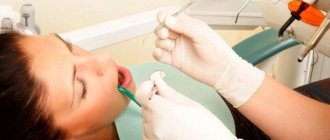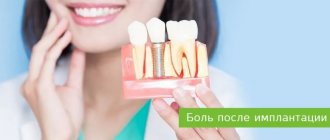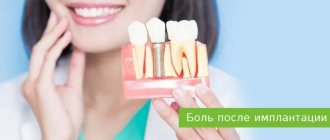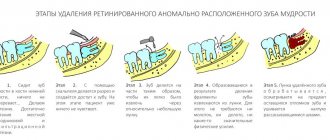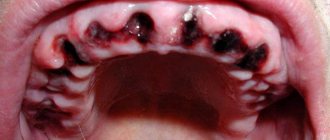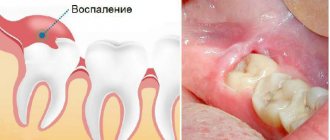Causes and duration of pain Mechanism of pain Localization Stages of healing Possible complications When to see a doctor What to do after removal What not to do How to reduce pain
Tooth extraction (removal) is a surgical intervention accompanied by damage to the periodontal tissues (gums, bone socket, mucous membrane). Pain after tooth extraction is a normal reaction of the body to surgery. Depending on the complexity of the clinical situation, the volume of the operation, after the procedure, when the effect of the anesthetic wears off (after 3-4 hours), the patient begins to feel aching pain in the injured area.
Why and how much does it hurt?
Pain occurs due to traumatic swelling of tissues and compression of nerve endings. The more complex and extensive the operation, the more intense the gum pain after tooth extraction. Normally, symptoms after extraction of an incisor or molar are as follows:
- Aching pain persists for 1-3 days
, but subsides day by day; - slight swelling, hematoma, redness around the removed unit (may increase for 2-3 days
and then subside); - formation of a blood clot in the wound;
- the appearance of a whitish coating (fibrin, which accelerates tissue healing).
This is a normal reaction to surgery. How much a tooth hurts after extraction depends on the complexity of the operation, the characteristics of the body, the patient’s pain threshold, the location of the dental unit in the row (after extraction of molars, the injury is more extensive and worries longer). Normally, discomfort lasts
3-5 days
, gradually subsides and disappears on its own.
Tissues are restored
about
10-14 days
. By this time, the mucous membrane has completely healed, new bone begins to form inside the hole, which will completely fill the defect in about six months.
The most difficult to treat and remove is the 3rd molar (figure eight, wisdom tooth). They have very curved, intertwined roots. A wisdom tooth is often completely unerupted (impacted), covered with mucous or bone, and incorrectly erupted (dystopic). The operation is hampered by difficult access to the figure eight. Therefore, healing after a complex 3rd molar extraction may take longer (about a month). But if pain and swelling have not begun to subside a week after the intervention, you need to consult a dentist.
2. After what time can you eat and drink?
After removal, you can drink water. After two hours you can eat. The limiting condition is not to chew rough food on the side of the extracted tooth in the first few days. Hard food can damage the blood clot, which is located in the socket and is needed for wound healing. If the patient experiences an acute feeling of hunger, then no one forbids eating cool yogurt or kefir. In the first days of healing of the hole, it is better to completely avoid eating rough, hard, solid foods, so as not to make strong chewing movements, as well as spicy, salty foods, so as not to irritate the oral mucosa. It is also important to monitor the temperature of food and drinks; they should not be too hot.
Mechanism of pain
- Trauma to soft, hard periodontal tissues;
- damage (rupture) of the connective tissue holding the tooth;
- destruction of blood vessels and nerve endings;
- swelling of the injured gum, pressure on nearby areas, poor circulation;
- irradiation of pain along the nerve trunks to other parts of the maxillofacial areas.
Pain after extraction of any dental unit is a natural reaction of the body to the intervention. No matter how carefully the surgeon acts, the integrity of the vessels, nerves, and fibers is inevitably compromised. It is normal for the extracted tooth to hurt for no more than 2-3 days.
, after removing the figure eight, the gums may bother you
for about a week
. If after 7-10 days the discomfort does not disappear, but continues or increases, you need the help of a doctor.
Localization of pain
As a rule, painful sensations are localized in the area of innervation of nerve endings injured during the intervention. Depending on where the hole is located, the pain can radiate to the throat, temple, or ear. Often, after tooth extraction, the neighboring tooth hurts. The most common reason is damage to soft tissues from instruments, which causes the gums around the wound to swell, begin to hurt, and the pain spreads further to neighboring units.
Incisors and canines usually have 1 root, which makes their removal the least traumatic. Chewing units have 2-3 or more roots, which complicates the operation and makes it more voluminous. The back teeth of the upper jaw border the bottom of the maxillary sinuses; after removal, the pain can radiate to the nasopharynx, cheek, orbit, and ear.
If after the removal of the lower tooth the jaw hurts, especially when it comes to multi-rooted chewing units (7, 8 teeth), this is normal. Usually such sensations go away within a few days. You need to go to the dentist if the pain does not subside after 5-7 days and is accompanied by other alarming symptoms.
Information on the use of drugs
If the procedure was not complicated, it is quite possible that painkillers will not be needed during the recovery period. But it’s better to take an analgesic half an hour before the end of the anesthesia (the doctor will tell you about the approximate time). This will help prevent pain, which is almost inevitable after a complex removal, accompanied by drilling the bone, opening an abscess, cutting out affected tissue, suturing, etc. Drugs such as ketanov, nimesil, nimik, etc. will help you quickly cope with pain. Among other things, they also have an anti-inflammatory effect.
The patient must inform the doctor about his state of health and existing diseases. This is especially important when it comes to arterial hypertension, diabetes, hemophilia, and low platelet levels in the blood. Your dentist should also know if you have a tendency to nosebleeds or have recently had an acute respiratory infection or the flu. In this case, the specialist selects individual methods for caring for the hole.
Stages of socket healing
- 2-3 hours
after
a blood clot (thrombus) forms
in the socket . It serves as a barrier to pathogenic microorganisms, preventing them from entering the wound. - The next 2-3 days
- the blood clot thickens, shrinks, the wound
becomes covered with a whitish coating
(fibrin film), the formation of granulation tissue begins inside the hole, the basis for the restoration of mucous membranes. - After 3-7 days
, the thrombus lightens, becomes whitish, the connective tissue has practically filled the hole, swelling and pain are minimal or completely absent. - After 7-10 days
, the hole has shrunk significantly,
new bone begins to form
, which will completely fill the defect after 4-6 months. - After 2 weeks
,
the gums have completely healed
.
What are the possible complications?
The intensity of pain must be carefully monitored. Unpleasant sensations must subside, otherwise it indicates the development of pathology. The gums hurt especially painfully after difficult removal if inflammatory complications develop:
- Alveolitis is an inflammation of the bone socket and surrounding tissues. accompanied by acute, throbbing pain, redness, swelling, the formation of yellow, greenish, dark gray plaque, cloudy pus with a putrid odor. The cause of the complication is poor hygiene in the postoperative period, ignoring the drug therapy prescribed by the doctor.
- Dry socket - there is no blood clot in the socket, it is dry, empty, there is a yellowish-gray coating, a putrid odor. The reason is that the clot was not formed due to a blood clotting disorder; the clot was removed from the socket by the patient during hygiene, intensive rinsing, etc.
- Socket bleeding - may be associated with a blood clotting disorder, excessive damage to tissues, blood vessels, or a fracture of part of the alveoli.
- Facial neuralgia is a rare complication that occurs due to damage to the facial nerve during tooth extraction. Accompanied by numbness in the cheeks, tongue, lips.
- Periostitis is a purulent inflammation of the periosteum that develops for the same reasons as alveolitis. Accompanied by acute, diffuse pain that cannot be relieved with an analgesic. Swelling is pronounced, can spread to the neck, temperature is above 38℃, general intoxication of the body is observed (headache, weakness, etc.).
- Osteomyelitis is a purulent-necrotic lesion of the jaw bone, accompanied by throbbing pain radiating to the ear, temple, fever, swelling of the gums and oral mucosa, spasms of the masticatory muscles, deterioration in general well-being, and enlargement of the submandibular lymph nodes.
Cheek pain after tooth extraction is a very common symptom, the duration of which depends on the complexity of the intervention. Normally, aching pain completely subsides after 2-3 days
. The picture is completely different when complications develop. With inflammatory complications, purulent foci form in the tissues, and the risk of spread of purulent contents through the general bloodstream increases many times over. There is a high probability of phlegmon, abscess, and destruction of bone tissue. Serious surgery and long-term rehabilitation are inevitable.
Antibiotics for gum inflammation -
The strategy for choosing an antibiotic for periodontitis, as well as the regimen of use, will be somewhat different. In most cases, antibiotics for gum inflammation are also prescribed “empirically”, i.e. without preliminary microbiological examination of the contents of periodontal pockets. But this may only be permissible for “mild severity” periodontitis. But with an aggressive course of periodontitis, as well as with moderate or severe periodontitis, we are obliged to refer the patient for microbiological examination.
The study will determine the composition of the microflora in periodontal pockets and determine its sensitivity to various antibiotics. For example, patients with moderate and severe periodontitis usually take antibiotics 2-3 times a year, which leads to the development of oral microflora resistance to them (i.e., many antibiotics will either not work at all or the effect will be negligible). It is also worth remembering that antibiotics can be used for gum inflammation only after preliminary removal of dental plaque.
Preparations "Tsiprolet-A" or "Tsifran-ST" -
If we do not send the patient for a microbiological study, then the 1st choice drugs will be 2nd generation fluoroquinolones. More precisely, these will be combination drugs that contain the combination “ciprofloxacin 500 mg + tinidazole 600 mg” (such combinations contain the drugs “Tsiprolet-A” and “Tsifran-ST”). Application regimen – 1 tablet. 2 times a day, for a total of 10 days.
Another option is that you can simultaneously take not a combination drug, but say, regular ciprofloxacin 500 mg 2 times a day, and in addition to it metronidazole or trichopolum - 500 mg 3 times a day (the course of treatment for each drug is only 10 days). Although this option is cheaper, it is worse. Metronidazole in this case will be a replacement for tinidazole. But in any case, you should not buy Russian-made antibiotics; for example, even Indian drugs are of much higher quality.
Important: the scientific work “Antimicrobial effectiveness of the systemic use of antibiotics of different groups in the complex treatment of patients with chronic generalized periodontitis” (Zorina O.A., Berkutova I.S.) shows that after the use of drugs such as “Tsiprolet-A” - in periodontal pockets 14 days after the end of antibiotic therapy, the lowest level of pathogenic bacteria is noted when compared with antibiotics of the macrolide group (azithromycin) and 3rd generation cephalosporins (Suprax).
Currently, the antibiotic ciprofloxacin is the only antibiotic in periodontal antibiotic therapy that suppresses absolutely all strains of A. actinomycetemcomitans (while it has minimal effect on the normal microflora of the oral cavity). In addition, when ciprofloxacin is administered orally, its concentration in periodontal pockets will be 8-10 times higher (compared to its concentration in blood plasma), and therefore ciprofloxacin is very effective against infection in periodontal pockets.
Combination of drugs “Amoxiclav + Metronidazole” –
We have already talked above about the antibiotics Amoxiclav and Augmentin, which contain a combination of amoxicillin and clavulanic acid. But if we need an antibiotic for gum inflammation, then we must combine one of these drugs - with metronidazole. Treatment regimen – Amoxiclav or Augmentin should be taken 1 tablet. 3 times a day (each tablet contains 500 mg of amoxicillin and 125 mg of clavulanic acid), as well as metronidazole - 500 mg 3 times a day. The course of treatment is 10 days.
Just do not buy cheap Russian metronidazole; it is better to take inexpensive metronidazole preparations from European manufacturers (for example, Trichopol or Flagyl). By the way, for patients who have gastrointestinal diseases associated with Helicobacter Pylori (peptic ulcer of the stomach and duodenum) - this scheme will also reduce the population of Helicobacter Pylori bacteria in the gastrointestinal tract.
Important: what to do if you need to choose between options - either the antibiotic Tsiprolet-A (Tsifran-ST) or the “Amoxiclav + Metronidazole” regimen. In principle, these 2 regimens are approximately equivalent - thanks to the addition of metronidazole to the drug Amoxiclav. But the “Amoxiclav + Metronidazole” regimen is still better, because in clinical studies it shows effectiveness against a significantly larger number of microbial associations in periodontal pockets.
Antibiotics for aggressive periodontitis –
Aggressive periodontitis means that the destruction of the bone tissue around the teeth, as well as the periodontal attachment of the teeth to the bone, will occur very, very quickly (24stoma.ru). Accordingly, tooth mobility develops in such patients many times faster than in patients with the usual course of chronic generalized periodontitis.
The development of aggressive periodontitis involves special types of anaerobic bacteria, which have the greatest destructive potential for the bone tissue around the teeth. We are talking about the “red triad” of anaerobic bacteria - these are Porphyromonas gingivalis, Tannerella forsythensis and Treponema denticola, the presence of which in a patient will mean a severe aggressive course of periodontitis. According to clinical studies, for aggressive periodontitis, one of the most effective antibiotics will be the antibiotic Moxifloxacin, which belongs to the 4th generation fluoroquinolones.
Important: in patients with aggressive periodontitis, it is fundamentally important to prescribe an antibiotic not empirically, but only after a microbiological examination of periodontal pockets (identifying the sensitivity of isolated microorganisms to different types of antibiotics).
When do you need to see a dentist urgently?
- Severe, acute, throbbing pain that is not relieved by an analgesic, spreads across the face, radiates to the ear, neck;
- bleeding from the socket that does not stop, but rather intensifies;
- absence of a blood clot in the socket;
- bad breath;
- discharge of pus from the wound;
- the formation of yellow, dirty gray, green plaque on the wound;
- temperature rise above 38℃;
- numbness of a part of the face (gums, cheeks) for more than a day;
- pronounced swelling of the gums and cheeks, which does not decrease 2-3 days after extraction.
What can and should be done after tooth extraction
- 20-30 minutes after the intervention, carefully remove the cotton swab
; - use cold compresses
for 2-3 hours after the intervention (take a break every 10-15 minutes to avoid tissue hypothermia); - for 3-5 days, make oral baths
with antiseptic solutions (take the solution, hold it in your mouth for a minute, spit); - When carrying out daily hygiene, avoid the injured area
, you can start using the toothbrush on the 2-3rd day, it should be new, with soft bristles; - chew on the opposite side
; - Eating is allowed after the anesthesia wears off (not earlier than 3-4 hours later
).
What is a sinus lift?
One of the most modern and safe operations to correct bone tissue in the alveolar processes is sinus lifting. It is a surgical intervention on the upper jaw, during which the bottom of the maxillary sinus is raised, and osteoplastic material is inserted into the resulting cavity. Rehabilitation after such an operation involves long-term adherence to certain rules and taking medications, for which the patient must be prepared.
Sinus lifting can be open or closed. The first involves the correction of large volumes of the alveolar ridge, and the second allows for immediate implantation of artificial roots. Sinus lift techniques are constantly being modified, so patients can be confident in the safety of surgery.
What is prohibited?
- To prevent accidental washing of a blood clot from the socket, it is forbidden to rinse your mouth. To treat the cavity, oral baths are quite sufficient;
- Hot compresses are prohibited, this stimulates severe swelling, the development of inflammation, and bleeding;
- You cannot puff out your cheeks, blow your nose too much, or sneeze;
- It is forbidden to touch the wound with your fingers, tongue, or objects;
- You can’t eat hot, cold, irritating foods; preference is for soft, warm, neutral foods;
- you cannot smoke or drink alcohol for at least a week - tobacco and alcohol slow down tissue regeneration;
- Hypothermia and overheating must be avoided - going to the sauna, swimming pool, solarium is prohibited for 5-7 days;
- Do not take aspirin or other blood thinners;
- do not engage in active sports, do not subject the body to excessive physical or sports stress.
Other causes of cheek swelling
Along with natural, so-called non-infectious inflammation, there are other causes of cheek swelling:
- tooth extraction due to gumboil;
- extraction with complications - in case of incorrect inclination or direction of tooth growth, when removing massive teeth and teeth with long roots;
- the presence of infection and inflammation in soft tissues;
- allergic reaction to medications or anesthesia;
- individual intolerance to components in medications or anesthetics;
- errors during extraction, insufficient antiseptic treatment of the oral cavity and residual infection;
- the presence of chronic diseases – hypertension, neuralgia, psycho-emotional pathologies;
- failure by the patient to comply with the recommendations of the dental surgeon, refusal of prescribed antibiotics or reduction of their dosage.
Most often, the tumor is caused by improper oral care, lack of disinfection with antiseptics, and skipping medications.
How to reduce pain?
Analgesics will help relieve pain after removal of a molar (or any other tooth) - it is better if it is one of the non-steroidal anti-inflammatory drugs (NSAIDs). Antihistamines will help remove swelling, and antibiotics will help prevent inflammation. The doctor will prescribe effective medications according to the clinical picture. Medicines should be taken strictly as prescribed. Treatment for pain after tooth extraction depends on the cause of its occurrence. The most important thing after the intervention is to scrupulously follow the dentist’s instructions and recommendations. This will help reduce recovery time and avoid complications.
Author of the article Voznyuk Vladimir Aleksandrovich Maxillofacial surgeon-implantologist of the highest category
Work experience: 28 years.
General information about bone grafting
Bone grafting is a common dental surgery to restore the volume of bone tissue in the jaws. This surgical intervention allows you to restore the patient’s dentition in the most physiological way possible through dental implantation (it is carried out together with bone grafting or after it). This treatment has many advantages over the installation of removable dentures, including the aesthetics of the smile and the correct distribution of chewing loads.
There are several osteoplastic techniques:
- Splitting of the alveolar ridge (the graft is immersed in the cancellous part of the bone, where it quickly and fully takes root);
- Replanting a bone block (engraftment is a little worse, since the graft is fixed on the side of the bone where there are practically no vessels, so it is advisable to use the patient’s own tissue);
- Guided tissue regeneration (a technique in which a very high-quality graft is used, and a positive result is guaranteed by fixation of a collagen protective membrane);
- Sinus lifting (surgery on the upper jaw, which involves the bottom of the maxillary sinus).
The dentist chooses the appropriate bone restoration technique independently. But no matter what technique he chooses, recovery after surgery will be the same everywhere. The patient should not forget that the procedure itself is not a 100% result. It is equally important to follow all the dentist’s prescriptions, including taking medications after bone grafting and sinus lifting (the most common bone restoration procedure).
